

Eating up the world’s food web and the human trophic level. Between Pigs And Anchovies: Where Humans Rank On The Food Chain. Hide captionAn animal's ranking on the food chain depends on where its meals place on the ladder.
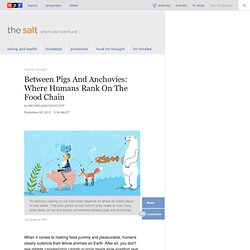
This Is What Lives Under Antarctic Ice. Colonies of bacteria cultured from samples of the water column from subglacial Lake Whillans.
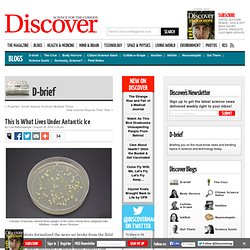
Credit: Brent Christner Today scientists formalized the news we broke from the field early last year — microbial life has been found 2,600 feet below the surface of the West Antarctic Ice Sheet in Lake Whillans. A paper published in Nature today reports that nearly 4,000 species of microbes inhabit the lake, the first organisms ever retrieved from a subglacial Antarctic lake. What the Deep Sea Sounds Like. At the bottom of the ocean, a network of underwater microphones eavesdrops day in and day out on the squeaky laments of whales, the rumbles of earthquakes and the drone of passing ships.
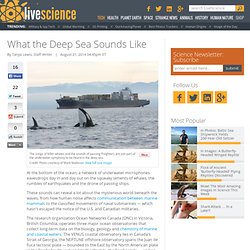
These sounds can reveal a lot about the mysterious world beneath the waves, from how human noise affects communication between marine mammals to the classified movements of naval submarines — which hasn't escaped the notice of the U.S. and Canadian militaries. The research organization Ocean Networks Canada (ONC) in Victoria, British Columbia, operates three major ocean observatories that collect long-term data on the biology, geology and chemistry of marine and coastal waters.
Conservation. Evolution. New maps change the conservation landscape. Bats Use Polarized Light As a Nighttime Compass. Polarized light is something people wear sunglasses to avoid, but for bats, it's actually useful, and can help them find their way.

The greater mouse-eared bat (Myotis myotis) is the first mammal known to navigate using polarized light — light waves that are parallel to each other and vibrate in a single plane. The bats use the scattered polarized rays at sunset to calibrate their internal compass and fly in the right direction, according to a new study, detailed today (July 22) in the journal Nature Communications. "Every night through the spring, summer and autumn, bats leave their roosts in caves, trees and buildings to search for insect prey," Stefan Greif, a biologist at Queen's University Belfast in Northern Ireland and co-author of the study, said in a statement.
Uncorking a Mystery: Is Climate Change Ruining Wine Corks? Wine lovers might treasure the oaky, full-bodied taste of a cabernet sauvignon or the light and fruity aroma of a pinot grigio.
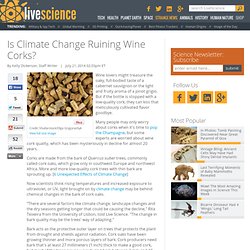
But if the bottle is stopped with a low-quality cork, they can kiss that meticulously cultivated flavor goodbye. 5 Scary Effects Of Climate Change That Could Happen In Your Lifetime. "Ballooning" Spiders Fly Without Wind. Check out this spiny-backed spider’s snazzy silk glands, magnified 490 times.
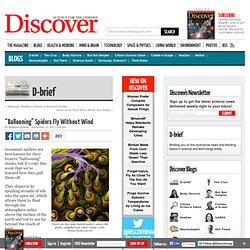
Image credit: Dennis Kunkel/arXiv. Small Animals See The World In Slow Motion. “Gene Drives” And CRISPR Could Revolutionize Ecosystem Management. The views expressed are those of the author and are not necessarily those of Scientific American.
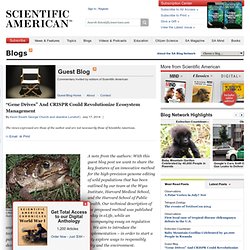
Invasive cane toads might one day be controlled with CRISPR gene drives. Photo Credit: U.S. Geological Survey A note from the authors: With this guest blog post we want to share the key features of an innovative method for the high-precision genome editing of wild populations that has been outlined by our team at the Wyss Institute, Harvard Medical School, and the Harvard School of Public Health. Our technical description of the proposed method was published today in eLife, while an accompanying essay on regulation and governance was published today in Science. Genome engineering technologies have revolutionized genetics, biotechnology, and medical research. Genetic Engineering to the Rescue Against Invasive Species? Invasive species wreak havoc worldwide, disrupting native ecosystems and inflicting more than $120 billion in damages annually in the U.S. alone.
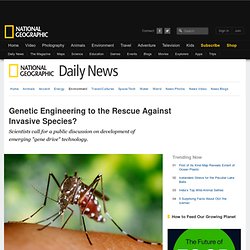
Many economically—and environmentally—damaging species, such as those mosquitoes, snakes, and carp, defy removal with existing technology. But there is good news. "Gene drives"—which could trigger a precipitous decline in invasive species by tinkering with their genetic machinery—have arrived as a fast-maturing technology, an international team of scientists announced on Thursday. "Once an invasive species arrives in a new habitat and is driving native species extinct, we don't necessarily have a lot of solutions to that.
Gene drive technology could potentially cause local extinction [of the invasive species] and restore the original ecosystem," says Kevin Esvelt, a genetic engineer at Harvard University and an author of tandem papers published this week in Science and eLife. How It Works. 23rd new bird species of 2013 discovered. Mongabay.com September 18, 2013 A ground-warbler from the Philippines is the twenty-third species of bird described in 2013.
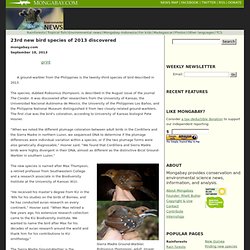
The species, dubbed Robsonius thompsoni, is described in the August issue of the journal The Condor. It was discovered after researchers from the University of Kansas, the Universidad Nacional Autónoma de Mexico, the University of the Philippines Los Baños, and the Philippine National Museum distinguished it from two closely-related ground-warblers. The first clue was the bird's coloration, according to University of Kansas biologist Pete Hosner. “When we noted the different plumage coloration between adult birds in the Cordillera and the Sierra Madre in northern Luzon, we sequenced DNA to determine if the plumage differences were individual variation within a species, or if the two plumage forms were also genetically diagnosable,” Hosner said. The Sierra Madre Ground-Warbler is the twenty-third species of bird described for the first time in 2013.
Shooting Owls to Save Other Owls. At dusk in a forest along Redwood Creek in northern California, Lowell Diller switches on his digital wildlife caller.
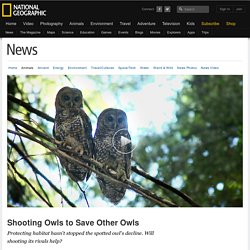
The eight-note call of a barred owl breaks the silence. Diller and Riley, his Brittany spaniel, listen for a response. Almost immediately the woods are filled with the deafening, cackling duet of a pair of barred owls, hooting to defend their territory against what they think is a rival. Software can decode bird songs. Revealed: The mystery behind starling flocks. The mystery behind the movements of flocking starlings could be explained by the areas of light and dark created as they fly, new research suggests.
The research, conducted by the University of Warwick and published in the journal PNAS, found that flocking starlings aim to maintain an optimum density at which they can gather data on their surroundings. This occurs when they can see light through the flock at many angles, a state known as marginal opacity. La superficie protegida para las aves marinas se multiplica por 20 en España. El Gobierno ha declarado 39 ZEPA (Zona de Especial Protección para las Aves) marinas nuevas, lo que supone multiplicar por 20 el espacio protegido existente actualmente en España y se convierte, según la organización SEO/BirdLife, en "un hito en la conservación del mar".
Estas 39 nuevas zonas protegidas se suman a los espacios integrados en Natura 2000, la red ecológica europea que garantiza la protección a la fauna que habita en ellas. El Boletín Oficial del Estado (BOE) ha publicado hoy la declaración, muy esperada por las organizaciones ecologistas. Shooting Owls to Save Other Owls. The Humans With Super Human Vision. An average human, utterly unremarkable in every way, can perceive a million different colors. Vermilion, puce, cerulean, periwinkle, chartreuse—we have thousands of words for them, but mere language can never capture our extraordinary range of hues.
Our powers of color vision derive from cells in our eyes called cones, three types in all, each triggered by different wavelengths of light. Every moment our eyes are open, those three flavors of cone fire off messages to the brain. The brain then combines the signals to produce the sensation we call color. Climate-Challenged Whale Sharks Flocking to Island Chain. Whale sharks are flocking to waters off of the Azore islands, a Portuguese archipelago in the North Atlantic Ocean, a new study has found. Whale sharks tend to enjoy warmer temperatures, but even this species has been affected by climate change, according to the study, which is published in the latest issue of the journal PLoS ONE.
It appears to be a Goldilocks effect where the sharks prefer temperatures that aren’t too hot or too cold. Things must be just right — at least for the momen t– in the Azores, which is becoming whale shark central. 5 Sharks, Rays Needing Urgent Protection: Photos. Heart of the Matter: 7 Things to Know About Your Ticker. Dynamics of Whale Shark Occurrence at Their Fringe Oceanic Habitat. Studies have shown that the whale shark (Rhincodon typus), a vulnerable large filter feeder, seasonally aggregates at highly productive coastal sites and that individuals can perform large, trans-boundary migrations to reach these locations. Google Takes On Rogue Methane Emissions With Street View Cars.
When Blown Apart, Hydra Re-Assemble. This article was originally published at The Conversation. Dead and Lost Boobies: Harbingers of a Growing El Niño? La red maravillosa de los atunes. Los túnidos se desplazan a lo largo de distancias enormes. Migran en busca de alimento y lo hacen nadando a gran velocidad. Pertenecen al grupo de los escómbridos[1], que son, de entre los teleósteos, los peces mejor dotados para la natación. Diver Saves Sea Turtle And Receives Adorable Thank You. Las maravillas de la flora - El nuevo órgano. Hints Of Hope Emerge In Deadly American Bat Plague. About 6 million American bats have died from white-nose syndrome since its mysterious 2006 debut, and the disease's rapid spread still threatens the survival of some species.
Nature Studies: Where are all the sparrows in London? - Comment. Noticias. Www.wmo.int/pages/prog/drr/transfer/2014.06.12-WMO1123_Atlas_120614.pdf. 8 charts that show how climate change is making the world more dangerous. Forget the future. New maps change the conservation landscape. Un equipo de investigadores de la Unión Europea recaba las opiniones de los ciudadanos sobre los mares. Los mares albergan una magnífica riqueza natural. La mitad de los rayos del sol que inciden en el planeta lo hacen sobre la superficie de mares y océanos, y es en ellos donde se crea otro tanto de la materia orgánica.
Los peces y crustáceos son la fuente de proteínas de origen animal que crece a un mayor ritmo del planeta. La inmensa diversidad de material genético de la que hace gala la vida marina ya se ha convertido en una fuente incipiente de alimentos y medicinas. No obstante, hasta la fecha no hemos logrado gestionar nuestros mares de manera sostenible y nos mantenemos impasibles ante la pérdida de esta inmensa fuente de recursos naturales. Los abejarucos no sólo comen abejas - ¡Cuánta Ciencia! Un estudi científic detecta la presència de fins a 10 espècies de planàries exòtiques a Catalunya.
Las hembras de piquero pardo montan a los machos durante el cortejo. Efectes de la invasió de la formiga argentina: el cas de la mallerenga blava. Why That Bass Beat Moves Us. Sleepless in Town – Drivers of the Temporal Shift in Dawn Song in Urban European Blackbirds. Artificial lighting and noise alter biorhythms of birds. Fish fossil yields jaw-dropping data on Man's past. Ancient Fish Fossil Discovered Has World's Oldest Recognizable Face From 419 Million Years Ago. Torrent frog has advantage attaching to rough, wet surfaces. Integration of molecules and new fossils supports a Triassic origin for Lepidosauria (lizards, snakes, and tuatara)
Eagle vs. deer. Conservationists develop novel way of choosing perfect new homes for species struggling in changing climate. Ecology: Gene tweaking for conservation. Using genes to rescue animal and plants from extinction. Www.birdlife.org/community/wp-content/uploads/2013/09/Wildlife-Comeback-in-Europe-the-recovery-of-selected-mammal-and-bird-species.pdf.
Get a Grip: How Frogs Hold on in Flowing Water. Black Widows: Facts & Information. How Cute! Trilobites Curled Up in Self-Defense. Updating Known Distribution Models for Forecasting Climate Change Impact on Endangered Species. El águila perdicera será favorecida por el cambio climático. Current Biology - Memory Processing: The Critical Role of Neuronal Replay during Sleep. Contagious Yawning. Good news for House Sparrows. Slow-motion world for small animals. Ligents s’estressen menys. L’escalfament global nocturn limita la captació de CO2 de la flora boreal. See Coral Reefs Like Never Before Thanks To Gorgeous New Panoramas. How To Nap & Eight Other Life-Affirming Lessons Animals Can Teach Us. Yawning Not Contagious for Children with Autism. Yawning Not Contagious for Children with Autism. Sleep Therapy Can Change Bad Memories.
The coelacanth leads a monogamous life. A New Cryptic Species of South American Freshwater Pufferfish of the Genus Colomesus (Tetraodontidae), Based on Both Morphology and DNA Data. Songbirds may have 'borrowed' DNA to fuel migration. Tree of Life Explorer - Tetrapods. Autumn Equinox: 5 Odd Facts About Fall. Jardí de bons endreços: És possible tenir una bassa sense mosquits i sense peixos? Shy Great Tit Birds Flock Together. These Are The Animals Of Your Nightmares. Math Serves Species Survival Research.
Cells Retrieved From Stratosphere Are Alien Life, Scientists Claim. How Do Blind Mole Rats Avoid Cancer? 23rd new bird species of 2013 discovered. Erythromma lindenii. Blue Whale's Earwax Tells Its Life Story in Chemicals.